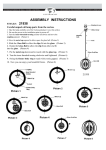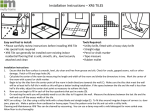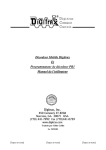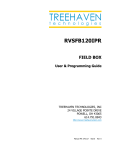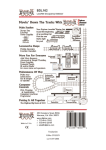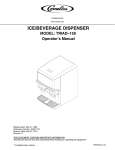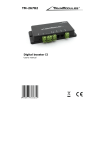Download RX4 Transponder Detector Installation Manual
Transcript
RX4 Transponder Detector Installation Manual Table of Contents 1.0 Introduction 2.0 Terminology 3.0 Plan Your Feedback System 3.1 Basic Transponding 3.2 Advanced Transponding 4.0 BDL16 Installation 5.0 The RX4 6.0 RX4 Installation 6.1 RX1 Sensitivity 6.2 Option Switches for BDL16 that affect transponding 7.0 Setting Up Locos & Other Rolling Stock for Transponding 8.0 RX4/BDL16 Troubleshooting: Checklist 8.1 Packet Reception-BDL16 8.2 Mode Indication-BDL16 8.3 Occupancy Debug-BDL16 8.4 LocoNet Debug-BDL16 8.5 Transponder Debug-RX4/Decoder or other transponder 8.6 Using a Test Transponder for de-bugging 9.0 Warranty and Repair Information 10.0 FCC Information 2 3 4 4 5 5 5 6 7 10 11 12 12 12 12 12 12 13 14 14 Digitrax, LocoNet, Genesis II, Empire Builder II, Chief II, Super Chief, and others included in this manual are trademarks of various manufacturers including Digitrax and others. There are many different manufacturers who build products that work with Digitrax, those used in this manual are for example only. U.S. & International Patents Pending for BDL16, RX4, transponding and other Digitrax products & technologies Copyright Digitrax, Inc. All rights reserved. Printed in USA. 1 REV 03/01 1.0 Introduction 2.0 Terminology The RX4 is 4 Zone Transponder Detector for use with the Digitrax BDL16 Occupancy Detector and Digitrax transponders. The addition of an RX4 allows the BDL16 to track and inform LocoNet of the layout location and identification of rolling stock equipped with transponders. Digitrax transponders are available as stand alone units which can be used to retrofit existing DCC decoder installations or can be installed separately in rolling stock that is not decoder equipped. Many Digitrax premium decoders come transponder equipped so that no retrofit is necessary. The following list of terms will be helpful as you learn more about Digitrax detection and transponding. Digitrax transponding is an area detection technology that works something like this: 1. Transponders (either included in a decoder or a separate transponder like a TD1 or TL1) installed in locos and rolling stock create small current pulses. 2. Transponder detectors (BDL16s with RX4s) installed on the layout use advanced digital signal processing, DSP, to determine which transponder is located in which transponding zone. 3. When a transponder equipped piece of rolling stock is located in a zone equipped with a transponder detector, information about the unit’s address and zone location is reported to LocoNet and can be displayed on a detection panel or computer screen, displayed in DT400 throttles, used for layout automation, etc. Power district is the power wiring, components and equipment attached to that wiring, driven by a single properly isolated booster. Power districts are double gapped on both ends. BDL16 is used to set up detection sections within one or more power districts. Each transponder is programmed with a unique address that lets the transponder detector keep track of many different transponders at the same time, even when they are located in the same transponding zone. Transponding can be used with most DCC compatible boosters and decoder installations. To make this work, just set up LocoNet wiring and hook up the BDL16’s and RX4’s. Transponding can also be adapted for use on almost any model railroad control method! Transponding detection technology works with current pulses that are so low that there is no danger of interference with decoders or track control signals. Transponding can be combined with other means of occupancy detection to set up a customized feedback system for your layout at a very reasonable cost. Direct home wiring is a layout wiring method where each power district and its booster is electrically isolated. The track within each power district uses a "common return" wiring method for occupancy detection and/or power management. Direct home wiring is the wiring method recommended by Digitrax for safety reasons & also because it makes detection work more prototypically. Power sub-district is the wiring, components and equipment that are controlled from both power bus wires by their own power management device, for example a reversing section controlled by an automated reversing device like the PM4. Power sub-districts are double gapped on both ends. Detection common is the common return used within a properly electrically isolated power district for implementing occupancy detection. Zone common is the common return used to implement zone transponding. Zone common connections to the booster should be as short as possible and relatively heavy gauge since they are common to all four detection sections in each zone. Security element is the plant, including track, associated with any reporting, interlocking and/or signaling for that track section. Whole layout common rail is a method of wiring layouts where power districts and their boosters are connected electrically by a common rail or common power bus return wire. This method is traditionally used for conventionally controlled layouts. The track feeds for one rail are connected together to one output of the power pack. The other rail is gapped and the track feeds are connected to the power pack through block control switches. Whole layout common rail wiring has a disadvantage when it comes to detection systems because detectors are not able to independently monitor whether zone power is on or off. There is no way to tell whether occupancy detection is actually working in any given detection section. Detection Section is a section of track gapped on one or both rails and con- 2 3 nected to an occupancy detector so that the detector can sense the presence of a loco (or other specially equipped cars) in that section of track. Occupancy detector is a device that senses the presence of a locomotive (or other specially equipped cars) in a section of track that is set up for occupancy detection. Occupancy detectors also provide feedback to indicate occupancy. This feedback may be in the form of a lamp on a control panel or it may be a feedback message sent to the system that can be used by other layout devices. Also called a block occupancy detector on conventional layouts. Detectors are not covered by the DCC Standards or Recommended Practices. Transponder is an electronic device with a transponder address that is installed in rolling stock. Transponders provide information to transponder detectors installed on the layout. This lets the system determine in which transponder zone the transponder is currently located. Transponders are included in many Digitrax premium decoders. TD1 (transponder) & TL1 (transponder with light output) are available as separate units that can be added to locos with existing decoders or to other rolling stock without decoders if you want to use them for transponding only and don't need motor control. transponding example presented here will show you how to set up 4 transponding zones each with 4 detection sections using one BDL16 & one RX4. For most layouts, this set up will be just what is needed. If your plan calls for other capabilities, instructions for more advanced options are also available. Before you begin planning and wiring your layout for transponding, you may want to set up a test transponder as described in Section 8.6 of this manual. This will help you become familiar with the concepts involved in setting up transponding and will be a useful de-bug tool as you proceed with the actual installation on your layout. 3.2 Advanced Transponding The combination of BDL16 & RX4 and the addition of other LocoNet components like the PM4 offer many additional possibilities for detection & transponding that are not be presented in this manual. Please visit our web site www.digitrax.com Application Notes and Technical Information page to print out additional ideas and examples for advanced transponding & detection. If you are not able to find these documents on the web site, our tech support staff will be happy to mail or fax copies to you upon request. 4.0 BDL16 Installation Transponder detector is an electronic device installed in a detection section on the layout that receives the information broadcast from a transponder. The transponder detector sends feedback to the system that lets it determine the detection section location of any given transponder at any time. RX4 Transponder detectors are hosted by the BDL16 and upgrade 4 detection zones of the BDL16 to be transponder detection zones. In this case, each transponding zone encompasses 4 detection zones. Transponder zone is an area of track that may be single gapped on one rail or double gapped on both ends and equipped with a transponder detector. Up to four detection sections can be included in a transponder zone. 3.0 Plan Your Feedback System Before you begin installing BDL16’s & RX4’s you should carefully analyze your layout and what you want to achieve with your feedback system. The best choice is usually a combination of detection sections and transponding zones. To use transponding effectively, you do not need to set up transponding on every section of track. By using transponding and other types of detection technologies in tandem, you will be able to get excellent performance and results at the lowest possible cost. 3.1 Basic Transponding This manual presents basic transponding & detection wiring. The zone 4 The BDL16 is used to host your RX4. It provides the LocoNet connection and wiring connections you will need to set up the layout for feedback. Before installing your RX4, you will need to have a BDL16 installed. The manual that came with your BDL16 will guide you through how to do this and how to troubleshoot problems with the BDL16. 5.0 The RX4 Each RX4 is made up of 4 RX1 sensors, a ribbon cable and a connector that let’s you plug the unit into a BDL16. The RX1’s are very sensitive to current. The detection level is sensitive enough that reliable detection & transponding can be achieved with transponding current levels of only 1-2% of the zone current. In most cases, a level of 20-30 milliamps is enough for dependable operation. For example, on a N-scale board decoder, the 470ohm dropping resistor that comes installed on the board is enough current for a zone of 2-3 amps. See Section 7.0 for more information about enabling your transponder equipped decoders for transponding. Because of the high sensitivity level of the RX1’s their placement relative to the zone common wires is important to avoid interference among the RX1’s installed on the layout. Follow the spacing instructions carefully to be sure you have the best operation possible. 5 In your installation, you will pass the zone common wire from the booster to the track through the RX1 sensor. The direction in which you do this is important. To make this easy, each RX1 has text on one side and is blank on the other. The instructions that follow will indicate which direction you should use to achieve the desired results. Digitrax RX4 Diagram Text Side R RX1 Patents Pending Brown/Red Ribbon RX4 Ribbon Cable Orange/Yellow Ribbon Black/White Not Used R Non-Text Side R Blue/Green Ribbon RX1 Patents Pending Connector for plugging in to BDL16 AUX2 header Gray/Violet Ribbon Each RX4 is made up of 4 RX1's Wire Color Brown & Red Orange & Yellow Green & Blue Violet & Gray 1. Plug the connector on the end of the ribbon cable connecting the four RX1 sensors that make up the RX4 into the AUX2 socket on the BDL16. Do not use the AUX1 socket for this connection. The black stripe on the cable should be plugged in towards the board edge connector side of the BDL16 board. 2. For each transponding zone you want to set up, a. Pass the zone common wire from the DCC booster’s Rail A (or B) terminal through the center hole of an RX1 from the "nontext" side and exit from the "text" side of the RX1 sensor b. Loosely twist the zone common wire together as you route it away from the RX1. Be sure you route the zone common wires at least 2” away from all other RX1’s. c. Connect the zone common wire to the appropriate pin on the BDL16's board edge connector. 6.1 RX1 Sensitivity RX1 Patents Pending Section 8.6 before beginning the first RX4 installation. Detection Zone Zone A Zone B Zone C Zone D The black and white wires in the RX4 cable are not used or connected. RX1 sensors are extremely sensitive to current, for best results: 1. The zone common wires that pass through each RX1 should be kept at least 2 inches from any other RX1 sensors. 2. Form these high current leads in a bundle away from the mounted RX1's. 3. The ribbon cables on the RX4 can pass close to the RX1's with no effect. 4. Transponding related option switches on the BDL16 should be set up. The factory setting for LocoNet Railsync polarity for a cable connecting the BDL16 to a DCS100 or DB150 is such that the default board polarity of the BDL16 is correct with the factory defaults. Option Switch 3 can be used to swap the board Railsync polarity 5. The presence of any active transponder in a transponding zone will cause that related zone power indicator LED to blink. When there is no transponder in a transponding zone, the LED will be on steady. It is useful to make up four of the 5 LED test cables as detailed in the BDL16 Manual. These will let you see the occupancy status of each of the 16 detection sections and also show zone power and transponding status, for simplified debug. Transponder capable software, a LocoNet message monitor and other transponder capable LocoNet devices can display the unique transponder messages, confirm those messages and use those messages to automate tasks on the layout. 6.0 RX4 Installation First time RX4 users may want to set up the test transponder described in 6 7 RX1 Text Side Brown/Red Ribbon Loosely twist zone common wires as illustrated here. Black/White Not Used Z Y W X V Zone B T U From Zone D RX1 H D E F J K L M N P R S Orange/Yellow Ribbon From Zone C RX1 B A C TOP ROW 8 7 6 5 4 3 2 1 C B A 9 10 11 12 13 14 15 16 17 18 19 20 21 22 DS 16 DS 15 DS 14 DS 13 Zone D DS 12 DS 11 DS 10 DS 9 Zone C Ext. Power Booster GRD DS 8 DS 7 DS 6 DS 5 Zone B DS 4 DS 3 DS 2 DS 1 Zone A D Detection Section 2 AUX1 AUX2 Use AUX2 ONLY! 2. To transpond accurately, each RX1 needs 2 inches in all directions free of any zone common wires from other zones. To 4 Detection Sections In Zone B We recommend that you bundle all zone common wiring and RX4 ribbon cable stripes as shown here, at least 2 inches from each RX1. See photo for example. From Zone B RX1 From Zone A RX1 Detection Section 3 RX1 Text Side Do Not Use AUX1 With RX4 1. Install all RX1's in the same orientation using double stick tape. 2.0" Note: Ribbon cable routing & spacing away from RX1's is not critical for optimal operation. 2.0" To Other LocoNet Devices A B R SCALE MODE O/G RUN O P N POWER ON HO SLEEP TRACK STATUS In this diagram some wiring is omitted for clarity. Wiring for all zones is similar to Zone A & B as shown here. Gray/Violet Ribbon Zone Common Wire Zone D 9 2.0" For best operation of transponding, RX1's should be located so that the zone common wires passing through each RX1 are kept at least 2" from any other RX1 sensors or layout wiring. OFF LINE To Zones A, B, C, & D 8 Zone C RX1 Text Side RAIL B RAIL A CONF B POWER IN GROUND CONF A POWER IN LOCONET Booster Set-up Connection To Zone C RX1 R Blue/Green Ribbon RX1 Text Side To 4 Detection Sections In Zone A To Zone A RX1 To Zone B RX1 2.0" To Zone D RX1 Detection Section 1 Zone A RX4 Ribbon Cable DB150 Detection Section 4 Transponding Zone A (double or single gapped), detection sections single gapped) Track This photo shows an example of how to set up a wiring panel for your BDL16 & RX4’s. Notice that the RX1’s are spaced apart by 2 inches on all sides so that the zone common wires can be routed to avoid interference between RX1 sensors. Notice that the BDL16 is located near the RX1’s. In this example, wiring from the power supply and the booster are routed through a terminal strip at the top of the photo. 6.2 Option Switches for BDL16 that affect transponding The default settings for the BDL16's option switches are indicated in bold type in the table below. OpSw 01 OpSw 03 OpSw 05 OpSw 06 OpSw 07 t=thrown Direct Home-Digitrax compatible Normal BDL16 LocoNet Railsync cable polarity. Affects detection and changes timing edge to be used for transponder detection. Disable Transponding RX4 connected OPSW6 and 7 MUST be “t” when RX4 connected. RX4 connected OPSW6 and 7 MUST be “ t” when RX4 connected. c=closed Common rail DCC logic Reverse BDL16 LocoNet Railsync cable polarity. Affects detection and changes timing edge to be used for transponder detection. Enable Transponding The BDL16 is sensitive to the Rail Sync polarity, OpSw 03 lets you change the BDL16’s setting to agree with what it sees when it is plugged in to LocoNet. If you have wired your LocoNet with all LocoNet cables in the same orientation, 10 all BDL16’s will see the same Rail Sync polarity everywhere on the layout. If your LocoNet has any cables that are wired in different orientations, you may need to use OpSw 03 to compensate for this by changing the expected Rail Sync polarity for each BDL16. 7.0 Setting Up Locos & Other Rolling Stock for Transponding 1. Your locomotive or other rolling stock that you want to use for transponding must be equipped with either a transponder device or a decoder with transponder included. Transponder devices such as the TD1 & TL1 can be added to non-transponding decoder installations. These devices are very small and easy to install. If you have not put decoders in your locos, it is easy to use a transponder equipped decoder and then you won’t have to add a second board inside the loco. For example, the Digitrax DN149K2 N scale Kato SD40 transponder equipped "plug and play" decoder is factory ready to transpond on most layouts with no additional modifications required to the decoder, locomotive or associated DCC boosters. 2. When you install a wired transponder equipped decoder, you should also install a load resistor of between 270 ohms & 470 ohms between the blue and white decoder leads. If you are using a board decoder, like Digitrax DN149K2, the resistor may already be installed on the decoder. Digitrax transponder current pulse generation uses the F0 decoder function lead that is also used for the forward light function. Transponding will not affect the operation of the forward light but you may see a slight glow when the light is turned off because of the way transponding works. If you are running zones where the average current draw is more than 3 amps, you can connect an additional 100 ohm 1/8 watt resistor in series with a 0.1uF ceramic capacitor across the white and blue decoder leads. Note: If the resistor is not connected between the blue & white leads, then the locomotive will transpond in only one orientation on the track. Note: If you are using TD-1 or TL-1 to equip your loco or rolling stock for transponding, you won’t need to install the resistor because it is included on the board. 3. Enable transponding in the transponder equipped decoder by programming CV61 to a value of 02. 4. Place the loco on the track, select it and run it back & forth. Verify that transponding is working in that orientation. If transponding is not working, be certain that the resistor described in step 2 above is installed properly between the white and blue leads of the decoder. 11 5. Pick up the loco and turn it around on the track, select it and run it back and forth again. Verify that transponding is working in that orientation. If transponding is not working, be certain that the resistor described in step 2 above is installed properly between the white and blue leads of the decoder. NOTE: Locos must be selected in the system for transponding to work. 8.0 RX4/BDL16 Troubleshooting: Checklist When troubleshooting the BDL16/RX4 installation, begin with the BDL16 since it must be working properly for the RX4 to work. 8.1 Packet Reception-BDL16 Be sure the BDL16's green ID LED is mainly on and briefly "winking" off approximately every 2 seconds. This means that correctly formatted DCC packets are being received. For DCC detection the same DCC packet signal that drives the Booster must be connected to the RJ12 socket left most pin. If this green led is not lit ever, check the external power connections. 8.2 Mode Indication-BDL16 The winking on the BDL16's green ID LED indicates the primary BDL16 mode. A single wink every 2 secs indicates standard Digitrax compatible Direct Home track wiring and detection logic will be used, a double wink indicates Common Rail wiring and detection logic is to be used. For Common Rail, all 4 BDL16 zone connections must be made to the System Common ground point. Be sure the BDL16 configuration is appropriate for your usage. 8.3 Occupancy Debug-BDL16 Each BDL16 comes with an LT5 that will help you with layout wiring and troubleshooting for transponding & detection with Digitrax BDL16 LocoNet Occupancy Detector. The LT5 plugs onto the LED Connections of BDL16 and the LEDS on the LT5 light when detection sections are occupied. The status of power to each zone is also shown. See your BDL16 manual for information about how to use the LT5. 8.4 LocoNet Debug-BDL16 If you are using LocoNet for reporting, be sure that the configuration is correct for your usage. In normal operations the BDL16's red OPTION LED will blink on briefly when valid LocoNet messages are seen confirming a good network connection. 8.5 Transponder Debug-RX4/Decoder or other transponder Be sure the BDL16 is functioning correctly as an occupancy detector. This shows correct power and LocoNet connections are present 1. Be sure that the zone you wish to test for transponding has a correctly 12 wired RX1. 2. Be sure that the zone common wire from the DCC booster passes through the RX1 in the correct orientation and that it is connected to correct pin on the BDL16's connector. 3. Be sure that the decoder in the test zone is transponder capable or that you have a transponder device installed. 4. Be sure there is a load resistor of 270 ohms to 470 ohm value between the blue and white leads of the decoder. 5. Be sure that transponding is enabled in the decoder by programming CV61 to a value of 02. 6. Even when the forward light/F0 is off, you may still see a slight glow in the lamp or LED because of the transponder current pulses being generated. Whether the F0/white lead or light is on or off does not affect transponding. 7. Be sure that there is power to the decoder. 8. Be sure the decoder is selected on a throttle and it responds to speed and direction commands. 9. Be sure the associated occupancy detection section gives an occupied reading. 10. If no occupancy is indicated by the associated zone indicator LED blinking, try reversing the BDL16 Railsync polarity by changing the state of OpSw 03. OpSw 03 only needs to be set up once during the initial installation. 11. If transponding is working when the loco is placed on the track in one orientation but is not working when the loco is picked up and placed back on the track in the opposite orientation, check to be sure that the load resistor is properly installed between the white and blue leads of the decoder. 8.6 Using a Test Transponder for de-bugging I am just learning about transponding and I am completely confused about how to do this. OR Nothing worked so what now??? You can use a Test Transponder as follows: 1. Use a DH142 or other transponder capable decoder set up with a 470 ohm resistor between the blue and white leads. This removes any lamp issues from initial transponding tests. The motor leads can be left unconnected/insulated and all other leads except the red/black track connections should be insulated. Set CV61 to a value of 02 to enable transponding. 2. Power up the BDL16 connected to a piece of flex track. 3. Use the first RX1 sensor (RX1 unit with brown/red leads in ribbon cable connected to AUX2 connector) and one leg of the track through the RX1. Connect the test transponder and select the address of this decoder/ Test transponder on a throttle. 4. If the Railsync polarity is correct, the zone power LED will blink 13 steadily about 2 times a second indicating that a valid transponder with that address is being detected in that transponding zone. If the zone indicator does not blink either (1) reverse the feed wire through the center of the RX1 or (2) change the setting of OpSw 03 for the BDL16. 9.0 Warranty and Repair Information Digitrax guarantees the RX4 to be free from manufacturing defects for five years from the date of purchase. These units are not user serviceable. If a defect occurs, return the unit to Digitrax for service. Digitrax will repair or replace your RX4 at our discretion at no charge to you for one year from purchase date. This warranty excludes damage due to abuse, such as failure to properly protect against input over current with a fuse or circuit breaker or applying excessive input voltage to the unit. Digitrax will make non-warranty repairs needed because of physical damage or electrical abuse at fair and reasonable rates. All warranties on Digitrax products are limited to refund of purchase price or repair or replacement of Digitrax products at the sole discretion of Digitrax. In the event that Digitrax products are not installed or used in accordance with the manufacturer's specifications, any and all warranties either expressed or implied are void. Except to the extent expressly stated in this section, there are no warranties, express or implied, including but not limited to any warranties of merchantability or fitness for a particular purpose. Digitrax, Inc. reserves the right to make changes in design and specifications and/or to make additions or improvements in its products without imposing any obligations upon itself to install these changes, additions or improvements on products previously manufactured. 1. Reorient or relocate the receiving antenna. 2. Increase the separation between the equipment and the receiver. 3. Connect the equipment into an outlet on a circuit different form that to which the receiver is connected. 4. Consult the dealer or an experienced radio/TV technician for help. Note that any modifications to the equipment not expressly approved by Digitrax voids the user's authority to operate under and be in compliance with CFR 47 rules, as administered by the Federal Communication Commission. Digitrax believes any conscientiously installed equipment following guidelines in this manual would be unlikely to experience RFI problems. 10.0 FCC Information Radio or TV Interference: (this information is MANDATED by the FCC) This equipment has been tested and found to comply with the limits for a Class B digital device, pursuant to part 15 of the FCC rules. These limits are designed to provide reasonable protection against harmful interference when the equipment is operated in a residential environment. This equipment generates, uses and can radiate radio frequency energy and, if not installed and used in accordance with the instruction manual, may cause harmful interference to radio communications. However, there is no guarantee that interference will not occur in a particular installation. If this equipment does cause harmful interference to radio or television reception, which can be determined by turning the equipment off and on, the user is encouraged to try to correct the interference by one or more of the following measures: 14 15









